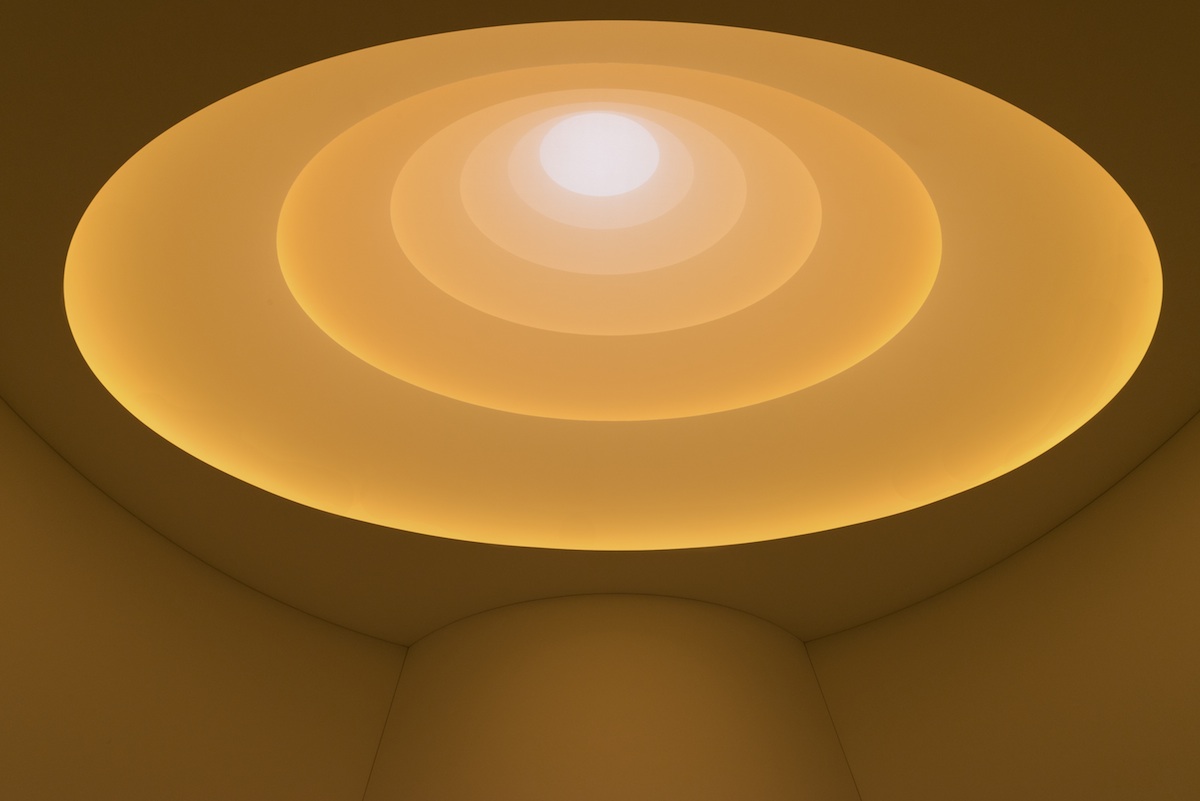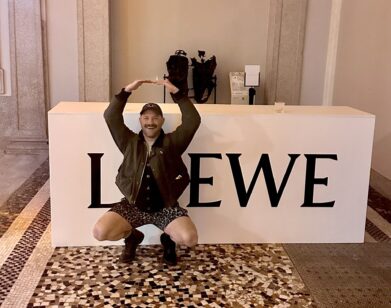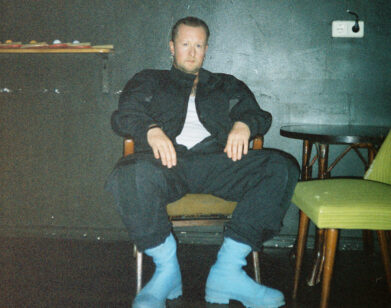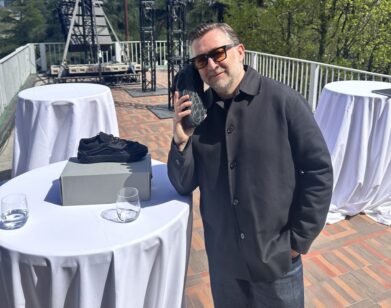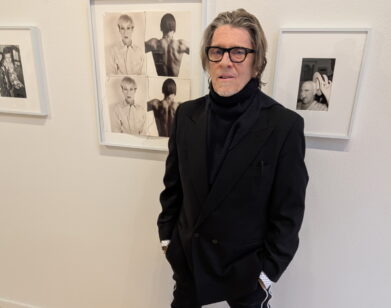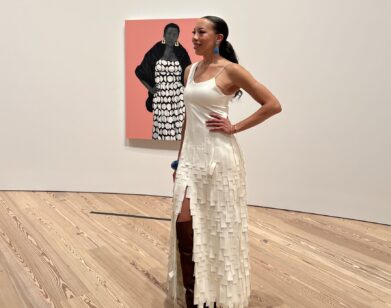James Turrell: Everywhere is Illuminated
Steps away from the casino thoroughfare of the Aria Resort, in Las Vegas, where the plinking roulette balls and slot machine handles are washed in a nonstop glow, there is a Louis Vuitton store. It’s one of the many high-end boutiques in Crystals at CityCenter, arguably Sin City’s shopping Mecca. Hidden on a top floor of this boutique is a double-cupola chamber containing a light quite different from the lights that give Vegas its nickname. In this Louis Vuitton store, there’s a ganzfeld by the canonical American artist James Turrell.
“Don’t take another step!” exclaimed the cute Vuitton maison employee, tiny and dressed in all white, as I strolled toward what appeared to be the back wall of the ganzfeld, a haunting, mesmerizing magenta-lit cave. What my mind saw as a hard limit, the Vuitton employee said, was actually air illuminated as if solid, with a steep drop-off beyond the precipice. I stuck out my hand, doubting, but there was no wall.
The optical illusion is typical of a Turrell work, though the California-born artist trades not in tricks but in total experiences, the kind that could produce in viewers something of an epiphany—you see the way light shades a room anew, with planes changing dimension and color as the eye and mind struggle to sync up. In that ovular catacomb that he calls a ganzfeld (it’s named for the Ganzfeld effect, a phenomenon of perception that allows for hallucination) the hues shift slowly from fuchsia to rose to clementine, and after a long stay, you understand Turrell’s mission, his 50-year quest to turn the elements of light and space into bona fide artworks. At one point, he purchased 155 square miles of Arizona ranch land to house the Roden Crater Project, where in an extinct volcano Turrell has installed a variety of installations that distort how we see the heavens. It’s been a work in progress since 1979.
The double ganzfeld in Vegas was just the first taste. At the other end of The Crystals, he has turned a monorail station into a neon glowstick, a coup secured by MGM Resorts International with the help of L.A. gallery Kayne Griffin Corcoran. Then there is one of his famous Skyspaces—a hut where a cut-out portal in the roof appears to be a painting, or a computer screen—located beside the sleek modernist home of James Murren, Chief Executive Officer of MGM Resorts. Murren, who has dedicated his high-powered position to bringing high-profile commissions to CityCenter, spoke about the importance of Turrell during a lunch at Picasso, a restaurant in the Bellagio stuffed with the Spanish painter’s masterpieces.
“I admire what he’s done as a rancher, a pilot, a patriot,” Murren said of Turrell, the famed Bellagio fountains bursting skyward in the background. “I think he’s the greatest living American artist.”
A few days later, I drove through the desert, the yellow sun setting over red barren land, to Los Angeles, where LACMA is exhibiting an extensive Turrell retrospective. Finally, back in New York, I visited his first New York exhibition since 1980, James Turrell at the Guggenheim, where he has turned the space between the Frank Lloyd Wright rotunda into a breathtaking work of art consisting mostly of dyed air. He calls it “Aten Reign.”
During a press conference following a sneak peek of the Guggenheim exhibit, Turrell, who was dressed in all-black cowboy duds and sported a flowing white beard, explained his life’s work. “An artist’s depiction of light within a work is something I am fascinated by, but I am more interested in depicting light itself,” he told the rapt audience. “This, I think, is a simple American idea.”
I spoke with Turrell, via my glowing laptop, a few days after the summer solstice.
NATE FREEMAN: You’re still in New York? It’s a sunny day in Manhattan.
JAMES TURRELL: Yes, we have an apartment here, in Gramercy Park.
FREEMAN: I’m not too far away right now. I’m on Houston Street, at Orchard Street.
TURRELL: Aha! But you have a number that comes from Escondido?
FREEMAN: Yeah, that’s actually a Google Voice number. I have a Maryland number. And you also have a Maryland number?
TURRELL: Yes, we have a house down there, in Oxford, on the Eastern Shore. Going down there tomorrow, in fact.
FREEMAN: It’s a beautiful state. So, I’ve seen a good number of your works in the last two weeks. I was in Las Vegas, then I was in Los Angeles, then I saw the exhibition at the Guggenheim, which is stunning and remarkable. How do you think it looks?
TURRELL: I’m pleased with how this has all been carried off, though I’m not that in touch with the reaction to it—as artists, we make these things, and then it’s out there. The reception at night was very nice! [laughs]
FREEMAN: It’s really taken the city by storm. Did you have a different approach than you do for your other pieces? It’s one of the biggest installations the Guggenheim has ever attempted.
TURRELL: Absolutely. It’s transforming it by taking it over completely. In some ways it’s similar to piece I did at the Millennium Dome [in London] in 2000, but this is much larger and taller, of course, and I’ve installed more light to come in during the day.
FREEMAN: I know you’ve worked with Louis Vuitton before, so that’s not necessarily surprising, but it was a jarring shift to walk through the casino in Las Vegas…
TURRELL: [laughs] It’s not even the casino, but also walking into the retail mall! And then into a very strongly lit and modern-designed Louis Vuitton store! And then you have to go to the elevator where you have to enter a secret code and then a floor that isn’t normally accessible! So it is quite a surprise. But in some ways it helps to see the contrasts. This is very different from what we think of think of Las Vegas. But Las Vegas uses light. I do, too.
FREEMAN: It does kind of make it more powerful when you have to walk through the casino. Were you ever tempted to sit down at the blackjack table while you were in town?
TURRELL: I gamble, but not in that way. I like a little better odds than that.
FREEMAN: I was also lucky enough to go to Jim Murren’s house to see his Skyspace, Arrowhead.
TURRELL: Jim took you up there? That was nice of him to invite you to see it.
FREEMAN: What struck me—we went there late, as dusk was setting—was that as you walked out of the Skyspace, you could see the strip below in the distance, the giant blinking row of hotels. Again, that juxtaposition between Las Vegas and your work was actually pretty powerful.
TURRELL: Yes, when you’re coming out, it’s to the right of you. I like that quality.
FREEMAN: So you were incorporating Sin City into the work?
TURRELL: You can’t help it. There it is. And you know what? It has a strangely positive look when you see it all displayed in light like that.
FREEMAN: And the monorail station you designed, in The Crystals? I know the architecture is strange, and you had to make due with odd hexagonal apertures.
TURRELL: I’ve always been interested in arrival, and coming to a space, and even to looking back at where you were. I worked a lot with Jim Murren on that, for CityCenter. He wanted something on the outside that people can walk through, and it’s more pass-through art, in a more normal situation—and it prepares you for what’s in the Louis Vuitton store. But I like when you feel like you arrive in a very different place, with a different ordering of the reality you normally think of. It is interesting to work in Las Vegas. I’ve always thought of Las Vegas as Los Angeles on its day off. There’s not any hierarchy of taste, and that’s what L.A. always was to me: It’s not really a town of culture, it’s a town of entertainment.
FREEMAN: Right. Some people might not have time for the double ganzfeld in the Louis Vuitton store, or they don’t know about it, but people on the monorail will have that very particular experience at looking at one of your works. Whether they want to or not.
TURRELL: I don’t worry about whether anyone knows anything about art. It’s just part of what they go through, and I’m happy that it works that way.
FREEMAN: Well, I enjoyed all your works in Las Vegas—in addition to the gambling and other extracurricular activities, of course.
TURRELL: Well, it is a place! And it is a bit of a contrast.
FREEMAN: I went to L.A. immediately after, to see the LACMA exhibit. Something always strikes me when I go out to Los Angeles is the way that the light affects people. It seems that the disposition of people is so different from people in New York—that somehow, as the joke goes, the amount of light has gotten to them. You were born in Los Angeles and began your career there. How does that affect showing the art there, in L.A.?
TURRELL: The people in L.A. do orient themselves to light. I used to call it “Tan Fascist Culture.” Everyone there is tanned, wears dark sunglasses, looks like a movie star even when they’re not. Here in New York, everyone is more pallid. I was a redhead. I can’t tan at all. So my physical and personal response to light, and the outside, is more like a New Yorker.
FREEMAN: I would have to agree.
TURRELL: Also, New Yorkers don’t tend to look up. You just stare at the second story—you watch for people to look up, and they don’t. So, perhaps that affects the way people here see the skyspaces, and the skylights, and particularly the skylight piece at the Guggenheim.
FREEMAN: I was looking at pictures of people looking up to the Guggenheim rotunda, watching people watch the colors changes, and I saw a picture of myself staring up! My face was dumbstruck.
TURRELL: Same here! I look like that, too.
FREEMAN: So what’s next?
TURRELL: I’m completing two works in Norway, one that’s in Oslo that opens in September. Then we’re having a convention, a get-together of people who own the skyspaces. You know, nametags, all that. We’re talking about maintenance, moving pieces, what happens after all these years, you know. This is the first time we’re getting all these people together, and it’s kind of like herding cats.
FREEMAN: And I want to ask a broad question about the Roden Crater—do you think it will ever be done?
TURRELL: Well, I want to see it myself. So we’re working toward. I bit off a lot more than I can chew with that one.
“JAMES TURRELL: A RETROSPECTIVE” IS ON VIEW THROUGH APRIL 6, 2014, AT LACMA; “JAMES TURRELL” IS ON VIEW THROUGH SEPTEMBER 25 AT THE GUGGENHEIM MUSEUM; AND TURRELL’S WORK IS CURRENTLY ON VIEW AT THE LOUIS VUITTON STORE IN THE SHOPS AT CRYSTALS AND THE MONORAIL STATION, BOTH AT THE ARIA RESORT IN LAS VEGAS. THE ARTIST’S WORK IS ALSO ON VIEW IN HOUSTON AT THE MUSEUM OF FINE ARTS‘ “JAMES TURRELL: THE LIGHT INSIDE” EXHIBITION, THROUGH SEPTEMBER 22.

